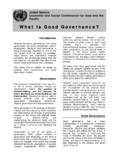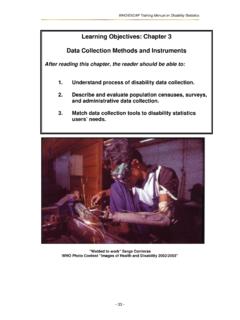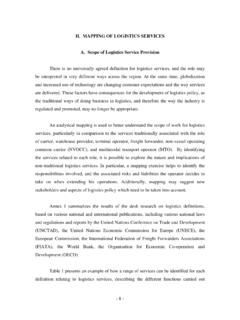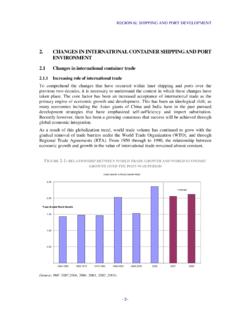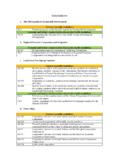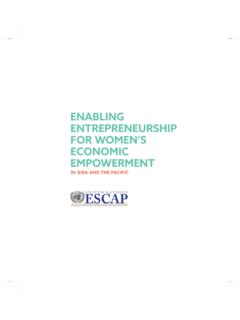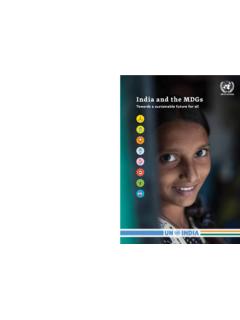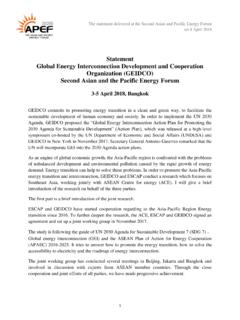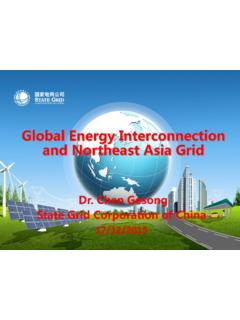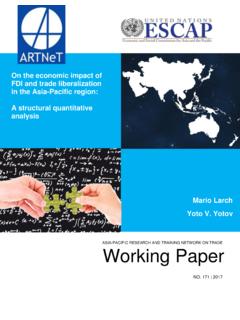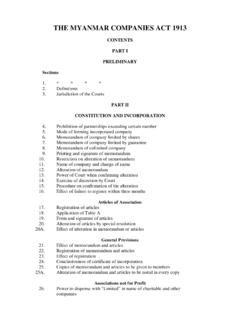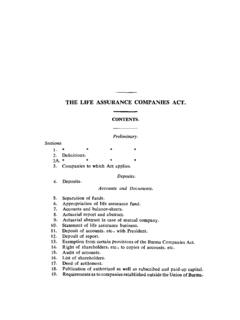Transcription of OECD-UNESCAP Multi-Dimensional Review of …
1 Masato Abe, PhD Economic Affairs Officer Trade and Investment Division United Nations ESCAP Bangkok, Thailand Multi-Dimensional Review of Myanmar Myanmar Business Survey: Objectives, Methodology & Results Outline Overview of the Multi-Dimensional Review Business survey Research design Methodology Implementation A guest speaker (Select results) My background Merchant / farmer s family Marketing, business administration & economics Japanese, Singaporean & US businesses Sales, marketing, supply chain management, logistics & procurement UN; Asia-Pacific, Southeast Asia New Myanmar SME Law 1. Overview of the Multi-Dimensional Review Objectives Identify the binding constraints in various fields to development in Myanmar Suggest a strategy with specific policy recommendations Propose action plan National authorities Economic and social actors International donors Research phases 2012-13 2013-2015 Present Future Biz Survey Research team ESCAP Trade and Investment Division, Business and Development Section OECD (lead organization)
2 Development Centre UMFCCI Myanmar Business Survey Team MNPED Focal-point ministry Cooperating agencies The Asia Foundation, GIZ, Japan, Mekong Institute, South Korea, Switzerland, UNIDO Others Key topics Macro economic stability Human resources Industrial transformation Agriculture Manufacturing Services Business environment Financing for development Social development Education Others Research method Data collection Non-structured qualitative interviews with various stakeholders Government Business Academia NGOs International donors Statistical data Literature Review Multi languages Burmese Team discussion Cross examination Follow-up interviews Team and individual missions Approx.
3 300 person days Research outputs OECD Development Pathways: Multi-Dimensional Review of Myanmar Volume 1. Initial Assessment (2013) Volume 2. In-depth Analysis and Recommendations (2015) Myanmar Business Survey Myanmar Business Survey 2014: Survey Results (2014) A comprehensive version (forthcoming) Other ESCAP studies Business and Development in Myanmar (2015) AEC Business Handbook (forthcoming) URL addresses #page1 #page1 2. Business Survey First-ever national wide survey for business All sectors, sizes, legal structures, ownerships , nationalities and States/Provinces Conducted by ESCAP/OECD/UMFCCI Donors: Japan, Germany, Switzerland, The Asia Foundation, UNIDO & Mekong Institute 3 months for data collection Background & project objectives Lack information on business conditions and environment Not much information in 2012-13 Assess the status of the business community Identify major obstacle in identifying effective policy recommendations Seven key issues enabling environment Legal regulatory framework Infrastructure (partially covered) to finance resources and technology development services (partially covered) & resource access Differences from other business surveys WB/IFC Business enabling environment (BEE) Enterprise survey (trade/market access focus)
4 650 samples Missing data Descriptive German Smaller scale Geographical limitation Narrower focus CSO/MOI Annual surveys for industrial estates under MOI JETRO (and IDE) Small scale and geographical limitation Other academic surveys What is a business survey? A detailed study of a business community, market or geographical area to gather data on attitudes, impressions, opinions, behaivours or satisfaction level Polling a section of the population Generalization and inference Why do we conduct a survey? Collecting data could be expensive and time consuming It is often impossible to observe all subjects in the entire population ( what we call a census) Rather a researcher will usually study a small sample, sometimes involving complex survey method(s)
5 To help cut down on the expenses and time The foundations of the business survey Target population => Myanmar business Sampling frame List of all the elements in the population with some chance of being selected Sampling methods Sampling instruments Interview Structured, semi-structured or non-structured Questionnaire Others Cost and time Inference using survey method Target population and sampling frame Myanmar business Target population Cover all types, size, ownership and nationality of businesses in Myanmar Foreign enterprises in Myanmar State owned enterprises Military enterprises Large enterprises Joint ventures/partnerships Small and medium enterprises Micro enterprises Cooperatives Informal sector Structure of Business Sector Foreign Enterprises State-owned Enterprises Military Enterprises JV JV JV JV Biz Associations Myanmar Enterprises JV JV Privatization Partnerships Cooperatives Target sectors Agribusinesses (but not subsistence farmers) Manufacturing Services Trading Also cover various sub-sectors in each of the sectors Constitution of enterprises Source.
6 IFC (2009) Self-employed Informal Sector Most businesses are small or informal Number Percentage Large enterprises 721 SMEs 126,237 Total 126,958 Informal sector 620,000 83% of entire business Source: President s Office (Nay Pyi Taw News, 14 January 2013) SME density is low Source: OECD , 2013. Different types of businesses in Myanmar Type Number Per cent Registration / supervision Legal framework State-owned enterprises 632 Various governmental offices State-owned Economic Enterprises Law (1989) Myanmar enterprises 30,135 MNPED/line ministries Myanmar companies Act (1914) (and companies Rules (1940); companies Regulations (1957)); Myanmar Citizens Investment Law (1994) Foreign enterprises 1,686 MNPED/line ministries Myanmar companies Act (1914) (and companies Rules (1940); companies Regulations (1957)).
7 Foreign Investment Law (2012) Partnerships 1,072 MNPED/line ministries Development Partnership Act (1932) Joint ventures between state owned enterprises and local enterprises 163 MNPED/line ministries Myanmar companies Act (1914) (and companies Rules (1940); companies Regulations (1957)); Special Company Act (1950); Myanmar Citizens Investment Law (1994); Foreign Investment Law (2012) Business associations 57 MNPED/MOC Myanmar companies Act (1914) (and companies Rules (1940); companies Regulations (1957)); Law relating to Forming of Organizations NGO Law (1988) Large sized manufacturing enterprises 4,808 MOI burma companies Act (1914); Private Industrial Enterprise Law (1990); Special Company Act (1950) Manufacturing SMEs 38,424 MOI Myanmar companies Act (1914); Private Industrial Enterprise Law (1990); Special Company Act (1950) Micro sized enterprises 13,309 Ministry of Cooperatives Promotion of Cottage Industries Law (1991).
8 Law Amending the Promotion of Cottage Industries Law (2011) Cooperatives in the primary sector 9,581 Ministry of Cooperatives Cooperative Society Law (1992) Hotels and tourism enterprises 5,790 MNPED/MOHT Myanmar Hotels and Tourism Law (1993) Total 105,657 Source: Various public sources Smaller food and beverage firms dominate manufacturing in Myanmar 0500010000150002000025000 Food and beveragesConstruction materialsClothing and wearing apparelMetal and mineralPersonal goodsRaw materialsLiterature and artsConsumer productsAutomobilesIndustrial tools and equipmentAgriculture machineryElectrical equipmentOthersLargeMedi umSmal lSource: Compiled by the author based on the data of CSO (2013). The Government has developed regional industrial zones & special economic zones as the main development strategy for Myanmar s industrialization Mingaladon has been the most successful industrial zone in Myanmar (2009-10) 05001,0001,5002,0002,5003,0003,5004,0004 ,500 MingalardonMyeikHlaingtharyarDagonseikka nShwepyitharDagonmyothit (East)Shwe Pouk KanTharkaytaNorth OkkalapaSouth DogonYangon WestMandalaySouth OkkalapaPatheinMyaungmyaMonywaMeiktilaPy ayMyingyanYangon SouthYenangyaungMawlamyinePakokkuHinthad aTaunggyiKale0100200300400500600 Sal es per fi rmGros s profi t per fi rmEmpl oyee per fi rmSource: Compiled by the author based on the data from CSO (2014).
9 Issues We have some broad idea about the status of business in Myanmar However, we do not have a comprehensive and reliable list to develop a sampling frame Unknown geographical distribution Fragmented dataset UMFCCI memberships Other business associations memberships Industry directories; Yellow Pages Government registrations, licenses or permits Various line ministries Population of the States and Regions Local information Questionnaire GIGO Garbage In Garbage Out (GIGO) Quality of questionnaire is a key success factor Topics & questions Statistics Descriptive Inference Multivariate or advance method Data collection Method Instruments Management Data entry Two crucial issues Missing data & Response rate Questionnaire development I Total design method for surveys (Dillman, 1978) Consulted with a number of industrial and country experts Reviewed many existing business survey questionnaires JETRO, 2009 and 2012; OECD, undated.
10 World Bank, 2013 Questions selected or modified from existing business surveys or newly developed Abe et al., 2012; DCED, 2008; IFC, 2008; ILO, 2003; JICA, 2006; MEF, 2005; Transparency International, 2014; WEF, 2013; World Bank, 2013 Questionnaire development II Fitted with advanced statistical techniques Multivariate statistics Conducted forward-backward translation Two professional English and Burmese translators Two separate questionnaires in Burmese and English Pre-tested with 13 business executives in Yangon Contained 73 questions Often use six-point Likert scale instruments Designed and printed in a professional looking format 20 pages in A4 Introductory statement signed by three agencies Difficult questions Examples Turnover Profitability Corruption Questionnaire (English) is available at: Sampling methods Good sample.
